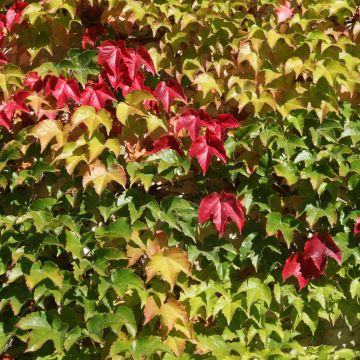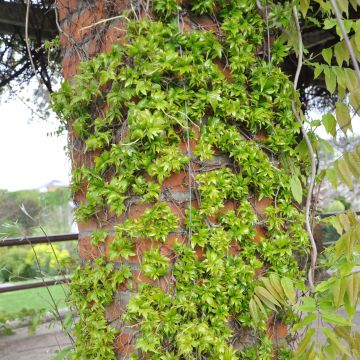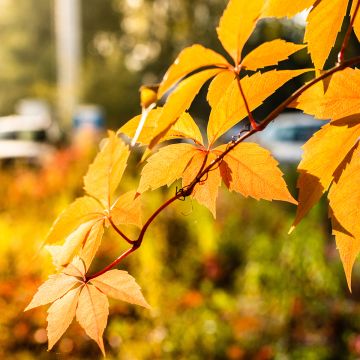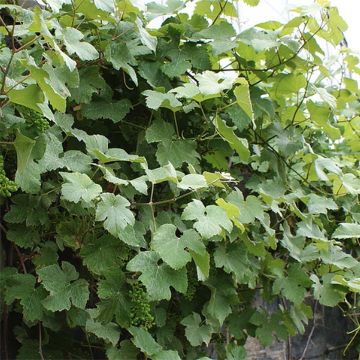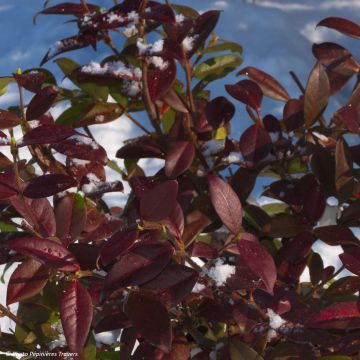

Parthenocissus tricuspidata Minutifolia- Boston Ivy


Parthenocissus tricuspidata Minutifolia- Boston Ivy


Parthenocissus tricuspidata Minutifolia- Boston Ivy
Parthenocissus tricuspidata Minutifolia- Boston Ivy
Parthenocissus tricuspidata Minutifolia
Boston Ivy, Japanese Ivy, Japanese Creeper
Why not try an alternative variety in stock?
View all →This item cannot be shipped to the selected country
Delivery charge from €5.90
Delivery to Corse prohibited
More information
Schedule delivery date,
and select date in basket
This plant carries a 6 months recovery warranty
More information
We guarantee the quality of our plants for a full growing cycle, and will replace at our expense any plant that fails to recover under normal climatic and planting conditions.
From €5.90 for pickup delivery and €6.90 for home delivery
Express home delivery from €8.90.
Delivery to Corse prohibited: UE law prohibits the import of this plant from mainland France to Corse as part of the fight against Xylella fastidiosa. Please accept our sincere apologies.
More information
Does this plant fit my garden?
Set up your Plantfit profile →
Description
The Parthenocissus tricuspidata 'Minutifolia' is a climbing plant with moderate growth, perfect for decorating walls or small facades, both in the ground and on balconies or terraces. Its beautiful deciduous foliage, composed of medium-sized lobed leaves, light green and vibrant in summer, takes on beautiful bronze and crimson to scarlet tones in autumn. This climbing plant, which attaches itself to its support through suction cups, can also form a beautiful ground cover. It is easy to cultivate: plant it in full sun, partial shade or even full shade, in ordinary but deep and well-prepared soil.
The Parthenocissus tricuspidata, also known as Boston ivy or Japanese ivy, belongs to the vitaceae family. It is native to eastern Asia (central and northern China, Korea, Japan) where it grows in woods and forests, as well as in rocky hills. This plant is naturalised in France.
The cultivar 'Minutifolia', obtained in France by Eugène Turbat in 1918, differs from the species by its greatly reduced growth and smaller leaves. It is a woody, deciduous climbing or creeping plant with a fairly rapid growth, not exceeding 3 to 4 m (10 to 13ft) in all directions at maturity. Its foliage is composed of long and wide leaves measuring 8 to 10cm (3 to 4in), with toothed lobes. They are shiny, purplish when they first emerge, then take on a light green and vibrant colour in summer. The autumn colours are magnificent, ranging from bronze-green to orange to deep red, with shades enhanced by a shiny texture. In summer, its insignificant but honey-scented white-green inflorescences give way to blue-black berries.
Boston ivy is elegant, romantic, and luxurious: it transforms any support into a flamboyant drapery at the end of the season, offering an almost unreal spectacle capable of attracting the gaze from afar and captivating the wanderer in a melancholic contemplation. It is perfect for adding lushness to both vertical and horizontal surfaces. The Parthenocissus tricuspidata 'Minutifolia', hardy up to -15°C (5°F), is very adaptable to different soil types and exposures, with its colours being more vibrant when its foliage receives sun for part of the day. Pruning it without constraints in any season will keep it within its space. With a compact size of 3 to 4 metres (10 to 13 feet), this Boston ivy is ideal for enhancing small spaces, as a wall cover or ground cover. It can be planted at the base of a wall or facade, or on a slope. In autumn, blue blooms are stunning next to its gleaming foliage. For example, it can be paired with Cerastostigma or blue asters (Aster cordifolius 'Blue Heaven', Aster laevis 'Calliope'). If the wall is sound, there will be no damage caused by the growth of the Boston ivy. It would also protect the habitat from extreme heat and harsh winters, according to recent studies.
Report an error about the product description
Parthenocissus tricuspidata Minutifolia- Boston Ivy in pictures
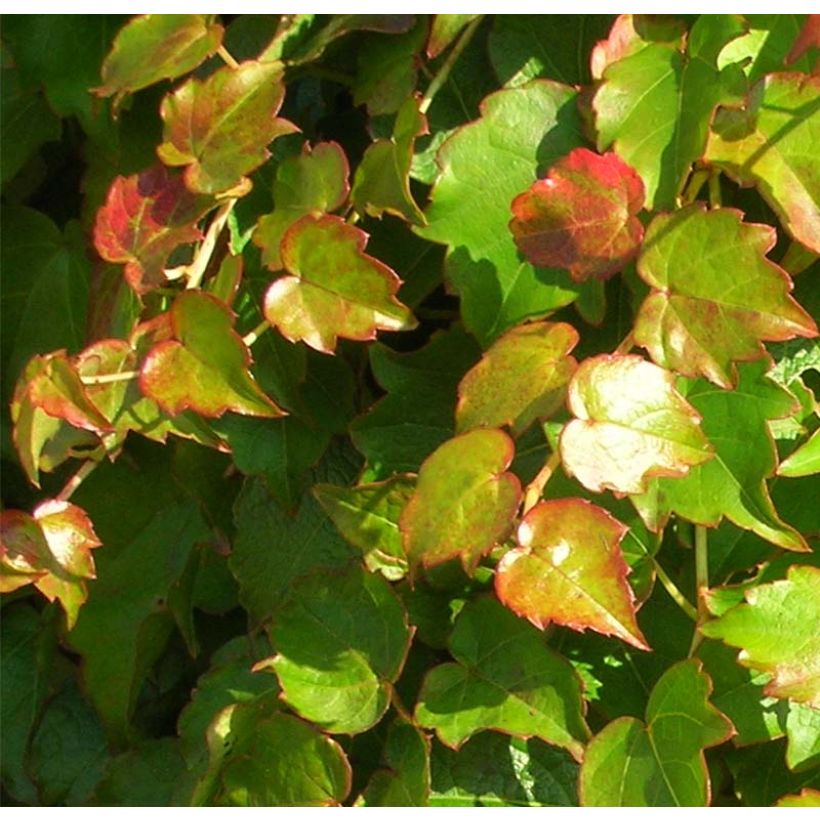

Plant habit
Flowering
Foliage
Botanical data
Parthenocissus
tricuspidata
Minutifolia
Vitaceae
Boston Ivy, Japanese Ivy, Japanese Creeper
Cultivar or hybrid
Other Parthenocissus - Virginia Creeper
Planting and care
The Parthenocissus tricuspidata is planted in autumn or spring and is easily cultivated in most of our regions. It prefers deep, fresh, fertile, clayey but well-drained soils. It is not very demanding in terms of soil pH, which can be slightly acidic, neutral or slightly alkaline, and it tolerates periods of moderate drought or deep soil once well established. Plant this creeper in a sunny or semi-shaded position to enhance the beautiful autumn colours. Be careful not to damage the root ball! Train the young plants until they can cling on their own. Monitor the growth of this non-invasive climber and pinch back misdirected voluble stems.
Planting period
Intended location
Care
-
, onOrder confirmed
Reply from on Promesse de fleurs
Foolproof climbers
Haven't found what you were looking for?
Hardiness is the lowest winter temperature a plant can endure without suffering serious damage or even dying. However, hardiness is affected by location (a sheltered area, such as a patio), protection (winter cover) and soil type (hardiness is improved by well-drained soil).

Photo Sharing Terms & Conditions
In order to encourage gardeners to interact and share their experiences, Promesse de fleurs offers various media enabling content to be uploaded onto its Site - in particular via the ‘Photo sharing’ module.
The User agrees to refrain from:
- Posting any content that is illegal, prejudicial, insulting, racist, inciteful to hatred, revisionist, contrary to public decency, that infringes on privacy or on the privacy rights of third parties, in particular the publicity rights of persons and goods, intellectual property rights, or the right to privacy.
- Submitting content on behalf of a third party;
- Impersonate the identity of a third party and/or publish any personal information about a third party;
In general, the User undertakes to refrain from any unethical behaviour.
All Content (in particular text, comments, files, images, photos, videos, creative works, etc.), which may be subject to property or intellectual property rights, image or other private rights, shall remain the property of the User, subject to the limited rights granted by the terms of the licence granted by Promesse de fleurs as stated below. Users are at liberty to publish or not to publish such Content on the Site, notably via the ‘Photo Sharing’ facility, and accept that this Content shall be made public and freely accessible, notably on the Internet.
Users further acknowledge, undertake to have ,and guarantee that they hold all necessary rights and permissions to publish such material on the Site, in particular with regard to the legislation in force pertaining to any privacy, property, intellectual property, image, or contractual rights, or rights of any other nature. By publishing such Content on the Site, Users acknowledge accepting full liability as publishers of the Content within the meaning of the law, and grant Promesse de fleurs, free of charge, an inclusive, worldwide licence for the said Content for the entire duration of its publication, including all reproduction, representation, up/downloading, displaying, performing, transmission, and storage rights.
Users also grant permission for their name to be linked to the Content and accept that this link may not always be made available.
By engaging in posting material, Users consent to their Content becoming automatically accessible on the Internet, in particular on other sites and/or blogs and/or web pages of the Promesse de fleurs site, including in particular social pages and the Promesse de fleurs catalogue.
Users may secure the removal of entrusted content free of charge by issuing a simple request via our contact form.
The flowering period indicated on our website applies to countries and regions located in USDA zone 8 (France, the United Kingdom, Ireland, the Netherlands, etc.)
It will vary according to where you live:
- In zones 9 to 10 (Italy, Spain, Greece, etc.), flowering will occur about 2 to 4 weeks earlier.
- In zones 6 to 7 (Germany, Poland, Slovenia, and lower mountainous regions), flowering will be delayed by 2 to 3 weeks.
- In zone 5 (Central Europe, Scandinavia), blooming will be delayed by 3 to 5 weeks.
In temperate climates, pruning of spring-flowering shrubs (forsythia, spireas, etc.) should be done just after flowering.
Pruning of summer-flowering shrubs (Indian Lilac, Perovskia, etc.) can be done in winter or spring.
In cold regions as well as with frost-sensitive plants, avoid pruning too early when severe frosts may still occur.
The planting period indicated on our website applies to countries and regions located in USDA zone 8 (France, United Kingdom, Ireland, Netherlands).
It will vary according to where you live:
- In Mediterranean zones (Marseille, Madrid, Milan, etc.), autumn and winter are the best planting periods.
- In continental zones (Strasbourg, Munich, Vienna, etc.), delay planting by 2 to 3 weeks in spring and bring it forward by 2 to 4 weeks in autumn.
- In mountainous regions (the Alps, Pyrenees, Carpathians, etc.), it is best to plant in late spring (May-June) or late summer (August-September).
The harvesting period indicated on our website applies to countries and regions in USDA zone 8 (France, England, Ireland, the Netherlands).
In colder areas (Scandinavia, Poland, Austria...) fruit and vegetable harvests are likely to be delayed by 3-4 weeks.
In warmer areas (Italy, Spain, Greece, etc.), harvesting will probably take place earlier, depending on weather conditions.
The sowing periods indicated on our website apply to countries and regions within USDA Zone 8 (France, UK, Ireland, Netherlands).
In colder areas (Scandinavia, Poland, Austria...), delay any outdoor sowing by 3-4 weeks, or sow under glass.
In warmer climes (Italy, Spain, Greece, etc.), bring outdoor sowing forward by a few weeks.


































